AROUND THE WORLD IN 80 FILIPINO ADOBOS
Up close and personal Pinoy adobos
Chapter 8
In this chapter on our search for the holy grail of Filipino adobos, I received several contributions from Filipino chefs, practicing their craft here and overseas.
Though great distances separate them, with their respective adobo dishes so disparate in ingredients, preparation and appearance, one would wonder what they could possibly have in common.
Whatever, it’s the feel-good memory of home, no matter where their paths may have taken them. Their personal adobo is forever etched in their hearts.
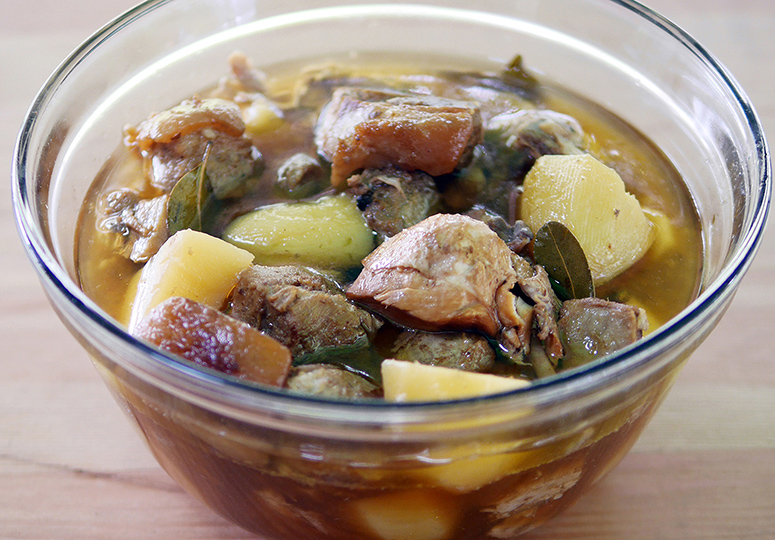
Masabaw na adobo (Saucy adobo): Lanai Tabura is a Filipino-Hawaiian DJ, comedian, actor, Emmy award-winning TV personality, and entrepreneur. He was the winner of the Great Food Truck Race Season Four on the Food Network in 2013. He was born on the Hawaiian island of Lana’i, after which he was named. Small island as it is, it nevertheless is the largest pineapple-producing island in the world.
Lanai was recently in Manila for business, and we caught up since his last visit three years ago as a guest of the DOT. He shared with me his adobo story: “I am a third-generation pineapple farmer. We also grew vegetables for our daily needs. Adobo is one of my favorite Filipino dishes and one of my go-to comfort foods. It’s that one dish that makes your mouth water if someone is cooking it and you just walked in the house. It brings nostalgia. It is culture. It is ono (delicious), as we say in Hawaii.”
I made sure there was always extra sabaw (soup/ sauce) for the rice. In my house, if there wasn’t enough of that tasty, thick adobo sauce for the next day, you were screwed.
“Growing up in Hawaii, we have a few different adobo styles brought about by the immigration waves of Filipinos during the early days of the sugar and pineapple plantations. My grandparents were from Cebu and had their own adobo style. My aunts from Ilocos Norte had theirs as well. But, what they all had in common was pork and chicken, and, of course vinegar, toyo, garlic, black peppercorns and bay leaves. If we had potatoes from the backyard we would add that. My grandfather also liked adding green finger chilies if we had them in the garden. But whatever type of adobo it was, there was plenty of hot rice and I loved it.
“I remember at a very young age my mother cooking chicken wing adobo in a rice cooker. There wasn't a crockpot in our house, and because she raised four boys on her own, she often didn’t have much time to cook. So in the morning she would prep and make it in the rice cooker, and by the time we all got home it was ready and still hot. Our adobo plate always had corn or mac salad as a side as well. I am salivating just thinking about it.
“When I first started making it at 14 years old, I made sure there was always extra sabaw (soup/ sauce) for the rice. In my house, if there wasn’t enough of that tasty, thick adobo sauce for the next day, you were screwed. We all know adobo is always better the day after. So it was mandatory you made a big enough pot to last a few days.
Growing up in Hawaii we really have gotten creative with the dish. Sometimes, our food truck Aloha Plate will serve adobo fried rice or the Adobo Loco Moco, which is really popular: hot rice, chopped-up day-old pork adobo with an over-easy egg on top, and some pickled onion on the side.” When people in Hawaii talk about Filipino food or any party or gathering, the top three must-haves on the table are lumpia, pancit and, of course, adobo.
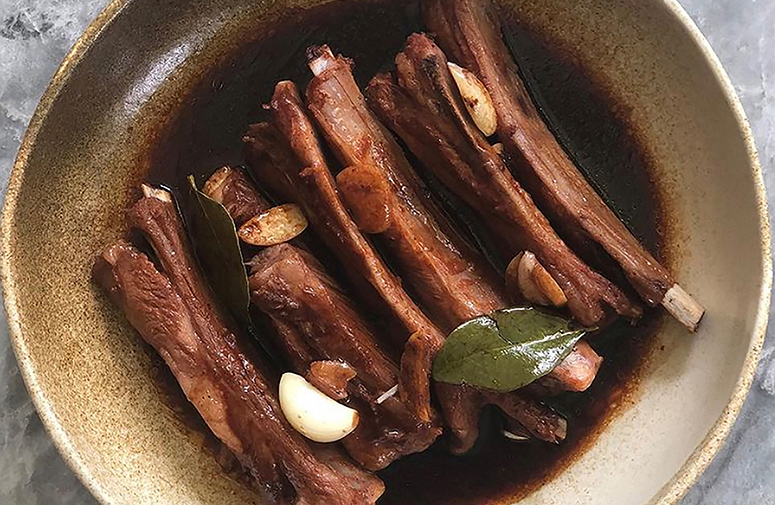
Lamb ribs adobo by chef Sunshine Puey: “This is my favorite adobo recipe because it’s so simple and uses only five ingredients, aside from the protein. I started making it during lockdown when ingredients were a bit difficult to come by. The key to this is using fresh laurel leaves, which grow in my garden. I think that’s what makes all the difference in the flavor. Though I normally cook chicken adobo, I’m using lamb ribs this time, following exactly the same recipe with the chicken adobo. The result is just as good.
For a kilo of meat of your choice: 1/2 cup soy sauce, 1/2 cup vinegar, 1 cup water or chicken stock, whole garlic cloves, 3-4 fresh laurel leaves, and 1/2 cup coconut milk. Season the meat with salt and pepper, and sear in a hot pan. Add the remaining ingredients except the coconut milk and simmer until the meat is cooked and tender. Finish with the coconut milk. Serve with steaming rice.
Chef Sunshine accepts food orders from her home under the name Gourmandise by Sunshine. For more inquiries you may call or text mobile 0917-883-2432. Visit their website and follow on Instagram
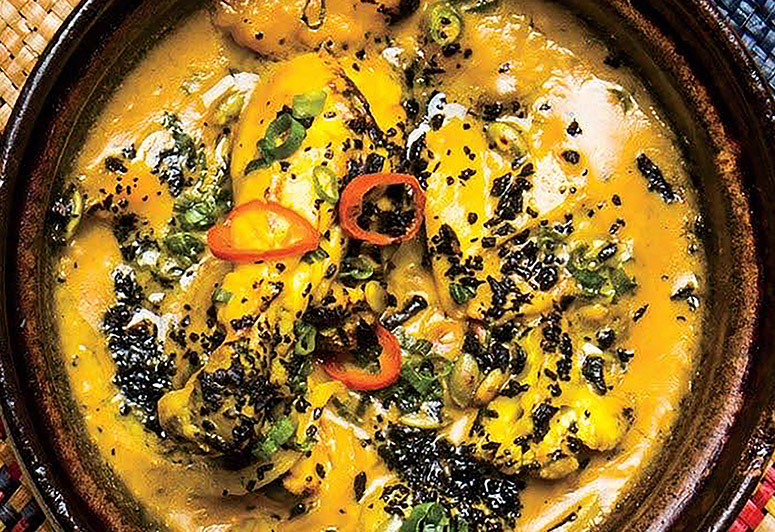
Adobong manok sa dilaw: Tom Cunanan is the award-winning chef behind the highly popular Filipino restaurant Bad Saints in the Washington, DC area. He wrote through email: “The Yellow Chicken Adobo, which I co-created with Paolo Dungca, is more like the adobo that changed the way I cook Filipino food. It taught me the variants of our country’s most beloved dish. My father cooked adobo in our family, which was the classic soy, vinegar, garlic and bay leaf. But this adobong dilaw (turmeric) served in the restaurant feels like my own.”
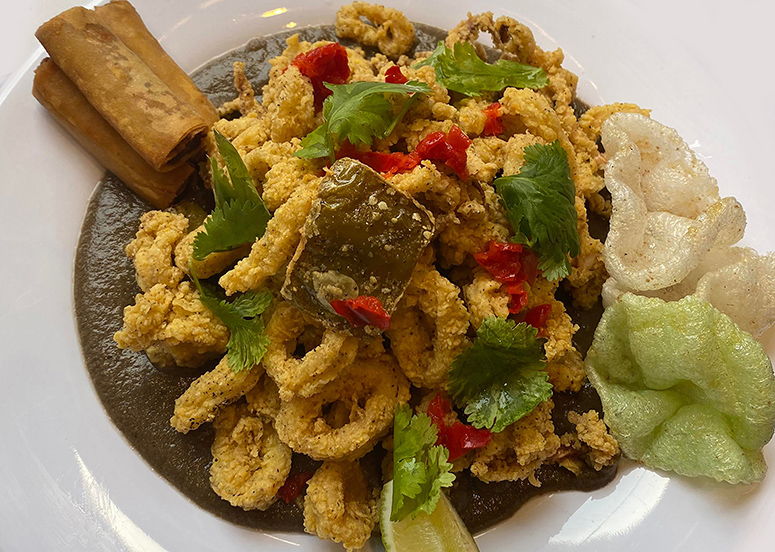
Squid adobo fritto misto: This time around, chef Tom partnered with another Fil-Am, Paul Qui, in Soy Pinoy Restaurant in Houston, Texas. Tom wrote: “Margarita Forés inspired me to put this dish together. I have a weakness for fried calamari. The sauce is made of squid, siling haba (green finger chili), tomatoes, onions, garlic, squid ink, and cane vinegar. It is cooked down together and then blended into a purée. The dredge (flour mix for coating the squid) contains semolina, all-purpose flour, baking powder, dry bay leaf powder, turmeric, sugar and salt. We pickle the siling haba first, and fry it along with the squid and tentacles. So, you get that burst of salt, heat, and acid from the crispy chili. It’s so good!”

Pork trotters adobo: Chef Rob Pengson serves this compressed pork trotter with aged adobo sauce on a bed of coconut-adobo paella and coconut foam at his restaurant Beso Beso in Makati City. He wrote in an email interview: “The adobo that has my attention these days is this boneless trotter adobo with a now eight-month-old aged adobo sauce we call ‘madre-adobo.’ The trotters are slow-cooked and peeled off a la Pierre Koffmann and Marco Pierre White (acclaimed British chefs). It is then pressed overnight, placed in the chiller to compress it, forming a gelatinized block. We save the sauce and add it into the madre-adobo and use some with demi-glace to serve.
When there is an order, we crisp the trotters (the skin stays gelatinous), and serve atop adobo paella rice and some gata (coconut milk) that we froth up. This is part of the tasting menu.”
Beso Beso serves preset tasting menus specializing in Spanish with a playful Filipino bravado. It is also an event place for large parties, as well as outside catering with residence service. For inquiries follow on Instagram.
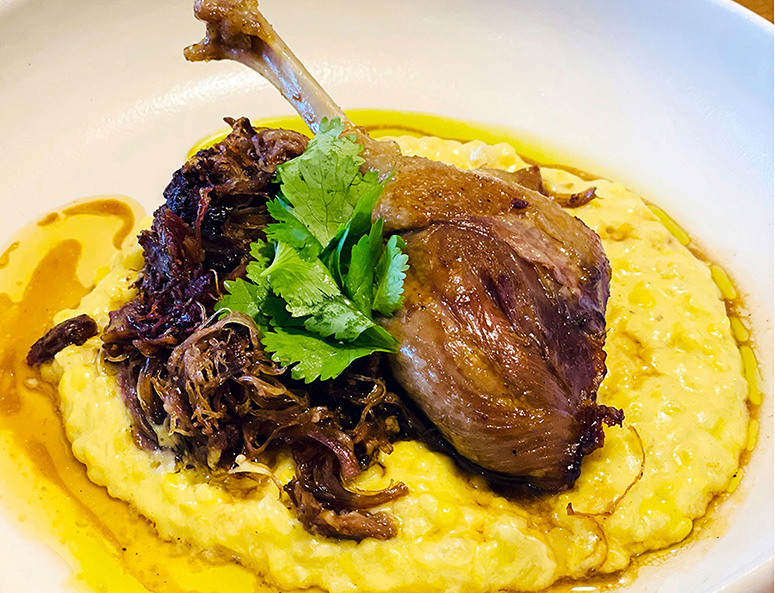
Duck adobo confit by chef Sau del Rosario: Having been trained in French classical cooking, my kabalen Sau tweaks the duck confit, cooking it with the familiar, down-home flavors of adobo and serving it two ways: whole leg and pulled-meat (shredded) on a bed of bringhe-inspired risotto. Bringhe (aka Valenciana) is the fiesta rice dish cooked with glutinous rice, coconut milk, turmeric, chicken, and flavored with patis. The duck confit is just one of the many delectable dishes chef Sau serves in Café Fleur, with branches in Poblacion, Makati, and Angeles City.
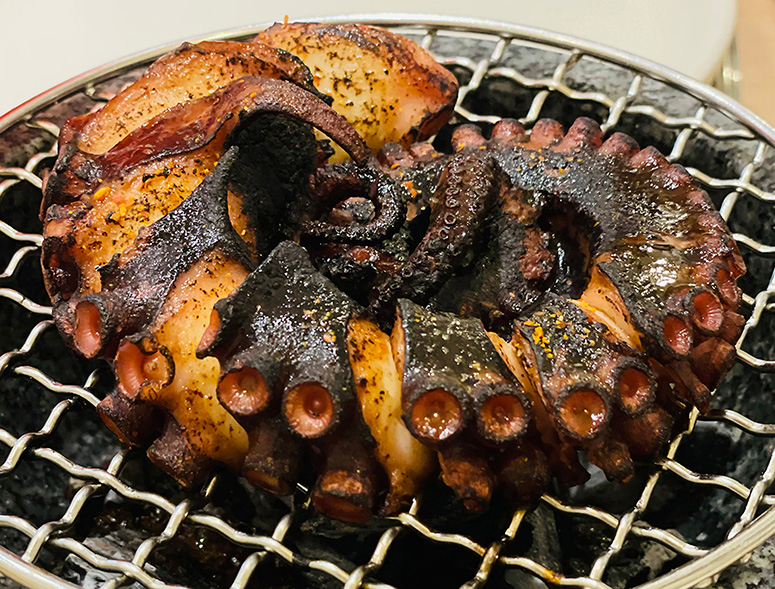
Grilled pulpo (octopus tentacle) with adobo glaze: Sawsaw is Sau del Rosario’s latest Filipino restaurant, located along Kalayaan Ave., Poblacion, Makati City. Pronounced “sao-sao” (think Sao Paolo, Brazil), it is not just a so-so joint (as a foreigner would pronounce it), but an excellent one at that. Sawsaw is a bon mot of Sau’s name, as well as the colloquial meaning of “to dip” (in dipping sauces or sawsawan) or to partake (makisawsaw).
The chef has come full circle from his Pampango roots to his French training in Paris, to finally back home on his own terms. In his Filipino dishes, he has captured the essence of what makes them Pinoy in taste, but every bit contemporary and relevant in presentation, with the refined sauces from his French honing. The pulpo is served on a mini charcoal grill, and simply glazed over with an adobo sauce. It’s perfection in its barest simplicity.


